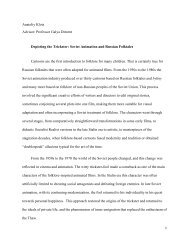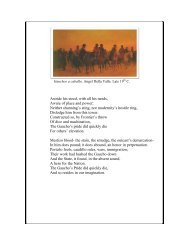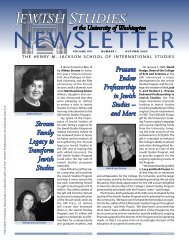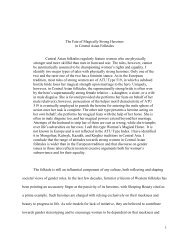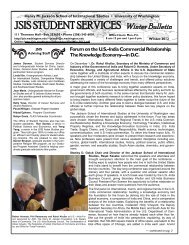Anatoliy Klots Advisor: Professor Galya Diment Depicting the Trickster
Anatoliy Klots Advisor: Professor Galya Diment Depicting the Trickster
Anatoliy Klots Advisor: Professor Galya Diment Depicting the Trickster
Create successful ePaper yourself
Turn your PDF publications into a flip-book with our unique Google optimized e-Paper software.
<strong>Anatoliy</strong> <strong>Klots</strong><br />
<strong>Advisor</strong>: <strong>Professor</strong> <strong>Galya</strong> <strong>Diment</strong><br />
<strong>Depicting</strong> <strong>the</strong> <strong>Trickster</strong>: Soviet Animation and Russian Folktales<br />
Cartoons are <strong>the</strong> first introduction to folklore for many children. That is certainly true for<br />
Russian folktales that were often adapted for animated films. From <strong>the</strong> 1930s to <strong>the</strong> 1980s <strong>the</strong><br />
Soviet animation industry produced over thirty cartoons based on Russian folktales and byliny<br />
and many more based on folklore of non-Russian peoples of <strong>the</strong> Soviet Union. This process<br />
involved <strong>the</strong> significant creative efforts of writers and directors to edit original stories,<br />
sometimes conjoining several plots into one film, making <strong>the</strong>m more suitable for visual<br />
adaptation and often incorporating a Soviet treatment of folklore. The characters went through<br />
several stages, from comparatively straightforward transformations in some early films, to<br />
didactic Socialist Realist versions in <strong>the</strong> late Stalin era to artistic, to masterpieces of <strong>the</strong><br />
stagnation decades, when folklore-based cartoons fused modernity and tradition or obtained<br />
“doublespeak” allusions typical for <strong>the</strong> art of <strong>the</strong> time.<br />
From <strong>the</strong> 1950s to <strong>the</strong> 1970 <strong>the</strong> world of <strong>the</strong> Soviet people changed, and this change was<br />
reflected in cinema and animation. The witty trickster-fool made a comeback as one of <strong>the</strong> main<br />
characters of <strong>the</strong> folklore-inspired animated films. In <strong>the</strong> Stalin era this character was often<br />
artificially limited to cheating social antagonists and defeating foreign enemies. In late Soviet<br />
animation, with its continuing modernization, <strong>the</strong> fool returned to his individuality in his quest<br />
towards personal happiness. This approach restored <strong>the</strong> origins of <strong>the</strong> trickster and returned to<br />
<strong>the</strong> ideals of private life, and <strong>the</strong> phenomenon of inner emigration that replaced <strong>the</strong> enthusiasm of<br />
<strong>the</strong> Thaw.<br />
1
Appeal of <strong>the</strong> <strong>Trickster</strong><br />
The trickster is one of <strong>the</strong> most appealing characters for animation. The trickster creates<br />
comic situations, brings innovation, and is often associated with satirizing norms and customs<br />
(Cherniavskaia, 435). The Russian trickster is <strong>the</strong> fool (durak). The fool in Russian medieval<br />
culture was a clever revealer of truth, eccentric in clothing, speech, and behavior (Likhachiov,<br />
350-351).<br />
There are several types of characters that have <strong>the</strong> trickster’s features in Russian folktales:<br />
<strong>the</strong> animal trickster (usually <strong>the</strong> fox), <strong>the</strong> soldier, and <strong>the</strong> fool. This essay will discuss how Soviet<br />
animation turned to Russian folklore motifs and how <strong>the</strong> figure trickster was treated in Soviet<br />
animation of <strong>the</strong> 1950s-1970s, specifically concentrating on <strong>the</strong> fool (Emelya and Ivan-Durak).<br />
Two popular films by prominent Soviet directors will be discussed, In a Certain Kingdom (1957)<br />
by Ivan Ivanov-Vano and The Flying Ship (1979) by Garry Bardin. How did animation aimed<br />
mostly at children in Soviet closed society treat <strong>the</strong> folktale environment and, in particular, this<br />
ambivalent and chaotic character? How did it change from <strong>the</strong> early post-Stalin years to <strong>the</strong><br />
period of <strong>the</strong> late Stagnation?<br />
In Russian culture, <strong>the</strong> trickster figure blends several characters that were historically<br />
connected: <strong>the</strong> Holy fool (iurodivyi), <strong>the</strong> Harlequin/Wandering Minstrel (skomorokh), and <strong>the</strong><br />
Outlaw (e.g. <strong>the</strong> thief, Cossack, or <strong>the</strong> peddler, ofenya). In peasant communities all of <strong>the</strong>m were<br />
aliens. They were seen with both fear and respect. In folktales this trickster is usually called <strong>the</strong><br />
fool (durak). The fool is often called Ivan/Ivanushka/Ivashko; sometimes Emelya. In most stories<br />
he is <strong>the</strong> third son of humble peasant parents or a widow’s son. Occasionally he is presented as<br />
<strong>the</strong> youngest son of <strong>the</strong> Tsar, Ivan-Tsarevich, a merchant’s son, or a human of animal descent,<br />
2
such as Ivan Medvedko. The fool is distinct in his clo<strong>the</strong>s, speech, appearance, actions, and <strong>the</strong><br />
unusual results of his adventures. The fool is often introduced as an unlikely hero: his parents<br />
and/or bro<strong>the</strong>r humiliate him; he is lazy, untidy and often has a problem with alcohol abuse. The<br />
fool spends his days lying on a stove (Emelya, Ivan <strong>the</strong> Fool). Unlike his bro<strong>the</strong>rs, <strong>the</strong> fool is a<br />
bachelor. He has not passed his initiation yet, and he is often seen as a child and acts like one. He<br />
is <strong>the</strong> only one who has a name; his bro<strong>the</strong>rs and parents are usually nameless. The fool does not<br />
fit into <strong>the</strong> social order and sometimes leaves <strong>the</strong> village or is even expelled. The fool manages to<br />
outsmart and enrage people; he acts oddly often treating orders in a literal manner. Outside of<br />
human society, in <strong>the</strong> primeval environment of <strong>the</strong> wild forest or by <strong>the</strong> water, <strong>the</strong> fool is<br />
challenged and successfully accomplishes more than his normal bro<strong>the</strong>rs (Siniavskii, 17). His<br />
weird behavior helps him both to get in touch with o<strong>the</strong>rworldly creatures (devils, Baba Yaga,<br />
talking animals) and often to outsmart <strong>the</strong>m. His social status is marginal until <strong>the</strong> end of <strong>the</strong><br />
story when he obtains riches, family, and sometimes power.<br />
The trickster became one of <strong>the</strong> most beloved characters of Russian literature: Ostap<br />
Bender and Benya Krik to name a few. In children’s literature, <strong>the</strong> figure of <strong>the</strong> <strong>Trickster</strong> became<br />
very popular: Buratino, Neznaika, Emelya, Ivan Tsarevich. The trickster is probably one of <strong>the</strong><br />
most appealing characters for animated media. Soviet animated tricksters include Emelya, Ivan<br />
Durak, Karlsson, Shapokliak. One of <strong>the</strong> earliest Soviet animated films, Ice Arena (Katok),<br />
features a trickster – a boy who manages to avoid paying <strong>the</strong> ice skate entrance fee, outsmart <strong>the</strong><br />
fat NEPman, and win <strong>the</strong> race.<br />
Folklore in Animation<br />
3
Russian animation (also known as “multiplikatsiia”) dates back to 1912 when Wladyslaw<br />
Starewicz produced his first stop-motion film featuring trickster figure of <strong>the</strong> Cameraman, The<br />
Cameraman’s Revenge (Mest’ kinematograficheskogo operatora). His second short, The<br />
Dragonfly and <strong>the</strong> Ant (Strekoza i muravei), 1913 based on Ivan Krylov’s fable, bridged <strong>the</strong><br />
strong connection between literary works and animation that became so characteristic of Russian<br />
cartoons. After <strong>the</strong> October Revolution, <strong>the</strong> famous avant-garde director of Kino Glaz and Kino<br />
Pravda, Dziga Vertov, employed animation principles for some of his propaganda reels, and in<br />
1924 produced <strong>the</strong> first Soviet animation, Soviet Toys (Sovetskie igrushki) aimed at greedy<br />
NEPmen and <strong>the</strong> clergy. In <strong>the</strong> 1920s, Soviet animators, toge<strong>the</strong>r with o<strong>the</strong>r artists of <strong>the</strong> NEP<br />
era, had some freedom for experimentation and worked in several studios (most well-known was<br />
Mezhrabprom Rus’) where such acclaimed directors as <strong>the</strong> sisters Valentina and Zinaida<br />
Broomberg, Ivan Ivanov-Vano, and Ol’ga Khodataeva. Soon after Stalin became <strong>the</strong> sole Soviet<br />
leader, film studios were consolidated. Stalin had realized <strong>the</strong> importance of state control of <strong>the</strong><br />
movie industry. In 1936, soon after <strong>the</strong> establishment of <strong>the</strong> major film studios Mosfil’m and<br />
Lenfil’m, Soyuzmul’tfil’m was founded and became <strong>the</strong> main animation studio of <strong>the</strong> Soviet<br />
Union.<br />
As a result of <strong>the</strong> turn from <strong>the</strong> internationalism of <strong>the</strong> 1920s to <strong>the</strong> fusion of Bolshevism<br />
and nationalism in <strong>the</strong> mid-1930s, interest in Russian topics in art was revived. The Second<br />
World War became a turning point in rehabilitating imperial cultural values. Under <strong>the</strong><br />
leadership of Stalin, <strong>the</strong> Soviet government tried to kindle Russian patriotism and in <strong>the</strong> late<br />
1940s launched a campaign against <strong>the</strong> “cosmopolites” who kowtowed to <strong>the</strong> West. This turn to<br />
national <strong>the</strong>mes made prominent Soviet film and animation directors adopt folklore motifs and<br />
characters for <strong>the</strong>ir works. In <strong>the</strong> 1930s-1950s animated pictures were often based on Russian<br />
4
tales (Ivashko and Baba-Yaga (Ivashko i Baba-Yaga), 1938; The Tale of <strong>the</strong> Soldier (Skazka o<br />
soldate), 1948; The Magic Swan-Geese (Gusi-lebedi) 1949; The Frog Princess (Tsarevna-<br />
liagushka) 1954.<br />
Initially avant-garde and satirical, Soviet animation changed in <strong>the</strong> middle of <strong>the</strong> 1930s<br />
with <strong>the</strong> establishment of Socialist Realism and was also influenced by <strong>the</strong> Disney animated<br />
films shown during The First International Film Festival in Moscow in 1935. Soviet animation<br />
turned toward productions for children. Control was tightened, and Stalin-era animation<br />
concentrated on mostly didactic animation for children. In such conditions, <strong>the</strong> trickster became<br />
a rare character in Soviet animation.<br />
During <strong>the</strong> Khrushchev Thaw, <strong>the</strong> spectrum of animation topics was significantly<br />
broadened. The annual number of cartoons produced by Soyuzmul’tfil’m increased from 10 in<br />
1948 to 36 in 1978. Apart from <strong>the</strong> Moscow studio, new animation studios were established,<br />
such as Ekran/Mul’telefil’m (Moscow), Sverdlovskaia Kinostudia, Permtelefil’m, and<br />
Kievnachfil’m. Soviet techniques shifted from Stalin-era Socialist Realist naturalistic cartoons<br />
that often employed rotoscoping, towards innovative methods (and rediscovery of <strong>the</strong> avant-<br />
garde aes<strong>the</strong>tics of <strong>the</strong> 1920s) causing a more cartoonish, abstract, and even surrealist<br />
appearance. Puppet and stop motion techniques were reintroduced. Folklore motifs, now not only<br />
Russian, remained important for Soviet animation. Such popular and critically acclaimed<br />
masterpieces based on folktales such as The Tale is Told (Skazka skazyvaetsia), 1970; Terem-<br />
teremok 1971; Vasilisa <strong>the</strong> Beautiful (Vasilisa prekrasnaia), 1977; The Flying Ship (Letuchii<br />
korabl’), 1979; <strong>the</strong> unforgettable Yuri Norshtein’s The Fox and <strong>the</strong> Hare (Lisa i zaiats), 1973<br />
and The Crane and <strong>the</strong> Heron (Zhuravl’ i tsaplia), 1974, and many o<strong>the</strong>rs were produced in <strong>the</strong><br />
1960-1970s. A long-standing tradition was continued in <strong>the</strong> post-Soviet period. One of <strong>the</strong> most<br />
5
outstanding efforts of <strong>the</strong> Russian animation industry is The Mountain of Gems (Gora<br />
samotsvetov), an animated TV-series produced in <strong>the</strong> recent decade and entirely based on<br />
folktales of <strong>the</strong> different peoples of <strong>the</strong> Russian Federation.<br />
Emelya in <strong>the</strong> Soviet Union<br />
Initially, folklore topics were considered inappropriate for <strong>the</strong> new Soviet art. They were<br />
seen as outdated and too much connected with <strong>the</strong> rural past (Kononenko, 274). However, with<br />
<strong>the</strong> revival of pride and interest in <strong>the</strong> Russian past, folklore became an inspiring source for both<br />
plots and characters (such as Koshchei, Baba Yaga, <strong>the</strong> soldier, and Ivan Tsarevich).<br />
In a Certain Kingdom (V nekotorom tsarstve) - <strong>the</strong> first animated film I would like to<br />
discuss in detail – was filmed using <strong>the</strong> rotoscope technique in 1957 by Ivan Ivanov-Vano, based<br />
on a screenplay by Nikolai Erdman, a prominent writer who worked not only for<br />
Soyuzmul’tfil’m, but also with Vsevolod Meyerkhold and, after arrest and exile, with Grigorii<br />
Aleksandrov (screenplays of Veselye rebyata (Jolly Fellows) and Volga-Volga).<br />
The story about Emelya <strong>the</strong> fool and <strong>the</strong> magic pike is among <strong>the</strong> most well-known.<br />
Emelya is depicted in figurines, paintings, illustrations, and sometimes is seen as a symbol of<br />
Russia, slow to saddle up, but rides fast. Emelya is <strong>the</strong> third son, unmarried, untidy, lazy, and his<br />
only motivation to do something is <strong>the</strong> promise of a red kaftan. Emelya manages to catch <strong>the</strong><br />
magic pike with his bare hands. The fool is not ambitious at <strong>the</strong> beginning and is satisfied by an<br />
opportunity to escape from hard everyday labor. For peasants who had to work hard to survive,<br />
this could have been an exciting fantasy. As <strong>the</strong> tale goes on, Emelya becomes an active<br />
trickster. Andrei Siniavskii points out that <strong>the</strong> tale’s attention to magic buckets, <strong>the</strong> axe, and <strong>the</strong><br />
moving stove makes Emelya a village magician, adding <strong>the</strong> charm of an entertainer and<br />
6
performer (Siniavskii 20). As <strong>the</strong> trickster, Emelya brings not only fun, but also chaos to a town<br />
by running over people with his sled, but managing to escape <strong>the</strong>ir revenge. He is full of self-<br />
respect and does not want to be treated poorly. For peasants, Emelya could have been a hero who<br />
is able to defeat <strong>the</strong> tsar and his men. In some versions, he sees his foolishness and becomes a<br />
smart and beautiful prince.<br />
In <strong>the</strong> folktale-based animated film V nekotorom tsarstve, Emelya is significantly different.<br />
The film omits his bro<strong>the</strong>rs and sisters-in-law; Emelya lives with his mo<strong>the</strong>r and he does not<br />
argue when she asks him for something. He is not a lazy lad sitting on a stove all day, but he is<br />
shown quite capable of working; he does not lie on a stove but sits and makes baskets. Making<br />
wooden utensils, baskets, and toys was typical for peasants during winter months. He also knows<br />
how to play a whistle and mentions his refrain “I am lazy” only once when summoned by <strong>the</strong> tsar<br />
Gorokh. Emelya is also kinder: he lets <strong>the</strong> pike go without asking anything and <strong>the</strong> pike rewards<br />
him. He does not want to beat angry villagers and is quite peaceful until his mo<strong>the</strong>rland is<br />
threatened by foreigners.<br />
Figures of pretentious westerners are among <strong>the</strong> main contemporary features of <strong>the</strong> film.<br />
The Cold War started about a decade before, and wicked foreigners were portrayed in Soviet<br />
animation again (e.g., Mister Uolk, 1949). The mass campaign depicting <strong>the</strong> West as mortal<br />
enemies was launched by <strong>the</strong> Soviet Union soon after <strong>the</strong> Marshall plan was introduced in 1947,<br />
and <strong>the</strong> death of Stalin did not stop <strong>the</strong> Soviet propaganda machine (Fatveev 1999). The generic<br />
foreigner is shown in 18 th -19 th century European dress. Presumably, he is a French prince who<br />
barely speaks Russian and wants to marry Marya, <strong>the</strong> daughter of tsar Gorokh. The foreigner’s<br />
carriage is overthrown by dashing Emelya’s horseless sleds. He is shown as a scrawny tall figure<br />
with unnaturally sharp features reminiscent of a rooster (possibly ano<strong>the</strong>r hint at his French<br />
7
origin). The prince is extremely effeminate, always powdering his face, looking at a pocket<br />
mirror, but Maria does not mind his courtship (approved by her fa<strong>the</strong>r) until Emelya sees her<br />
portrait and wishes her to fall in love with him. However, when <strong>the</strong> French prince is rejected by<br />
Marya, he launches an invasion. The image of foreign grenadiers marching in <strong>the</strong> snow reminds<br />
us not only of Napoleon, but also of <strong>the</strong> recent German invasion. The tsar’s troops are defeated,<br />
and only <strong>the</strong> trickster, becoming patriotic when he sees <strong>the</strong> destruction <strong>the</strong> invaders are causing,<br />
is able to save his native land by making a broom to wipe out <strong>the</strong> enemy. 1<br />
Emelya, Maria, and a soldier drummer who politely addresses <strong>the</strong> fool “Emelyan<br />
Ivanovich” are depicted in a humane fashion, with normal physical appearances. In contrast, <strong>the</strong><br />
Russian court is shown in a somewhat comical way: <strong>the</strong> tsar is short, bearded, and single too<strong>the</strong>d;<br />
his general is worthless with cartoonish whiskers. As a result of Emelya’s victory, <strong>the</strong> tsar loses<br />
his crown and flees abroad, while Emelya marries princess Marya and rides <strong>the</strong> stove home with<br />
her. Thus, in sharp contrast with <strong>the</strong> folktale, Emelya in this cartoon embodies <strong>the</strong> ideal of <strong>the</strong><br />
Russian nation: he is witty and kind, able to work and play, he is not aggressive, but he can<br />
defend himself if bo<strong>the</strong>red by foreigners or <strong>the</strong> tsar and his government. Foreign enemies are<br />
always ready to invade Russia, but <strong>the</strong>y cannot defeat her people. The second part of <strong>the</strong> tale that<br />
shows weakness and passivity (Emelya is imprisoned in a barrel and Maria begs him to do<br />
something) is completely omitted. In <strong>the</strong> film Emelya is a smart peasant, salt of <strong>the</strong> earth, and<br />
does not need <strong>the</strong> pike’s magic to become a handsome and clever prince.<br />
Soviet animation of <strong>the</strong> late 1940s-1950s was not as satirical as <strong>the</strong> animation of <strong>the</strong> NEP<br />
era, <strong>the</strong> 1930s and <strong>the</strong> war years. It was aimed at children to promote loyalty to <strong>the</strong> country, a<br />
positive attitude towards Socialist society, and <strong>the</strong> common values of friendship, honesty, and<br />
1 Literally executing, saying “гнать поганою метлой.”<br />
8
politeness (Pontieri, 44). The rise of nationalism promoted by <strong>the</strong> naturalistic Disney style was<br />
combined with traditional Russian plots (often based on folktales, fables, and fairytales of<br />
Russian authors) and aes<strong>the</strong>tics. Beautifully executed, <strong>the</strong>y were often burdened with didactic<br />
propaganda bringing Soviet ideals into <strong>the</strong> adaptation of folklore.<br />
Flying Ship of <strong>the</strong> Late Stagnation.<br />
During Khrushchev’s Thaw, Soviet animation adopted new techniques and <strong>the</strong>mes. New<br />
topics included technological progress (especially space exploration), modernization and <strong>the</strong><br />
struggle with <strong>the</strong> church and superstition, romanticizing <strong>the</strong> Revolution, and even satire aimed at<br />
Soviet shortcomings (bureaucracy, petit-bourgeoisie lifestyle, and alcoholism) (Pontieri, 57). The<br />
cartoons became less realistic and more schematic. One of <strong>the</strong> turning points was Story of a<br />
Crime (Istoriia odnogo prestuplenia, 1962), <strong>the</strong> first effort of Fyodor Khitruk 2 as a director. The<br />
animated film genre was no longer oriented exclusively toward children. The Flying Ship<br />
(Letuchii korabl’, 1979), an animated musical, produced by Garry Bardin with lyrics by Yurii<br />
Entin, became one of such films popular among both children and adults. The famous The<br />
Bremen Town Musicians (Bremenskie muzykanty, 1969) was one of <strong>the</strong> first animated films of<br />
this popular genre. It is loosely based on <strong>the</strong> Grimm bro<strong>the</strong>rs’ tale and featured a trickster<br />
Troubadour who resembled one of <strong>the</strong> Beatles, an attractive princess in a mini dress, and<br />
elements of rock music and hippy culture. Letuchii korabl’ follows this successful pattern but in<br />
a Russian folktale setting.<br />
Letuchii korabl’ is loosely based on <strong>the</strong> folktale of <strong>the</strong> same title. Unlike V nekotorom<br />
tsarstve, this film shares with <strong>the</strong> folktale only <strong>the</strong> image of <strong>the</strong> magic ship, a magic donor, and<br />
2 Fyodor Khitruk, who passed away this year, was a veteran-animator of many films, including V nekotorom tsartsve discussed above. In <strong>the</strong><br />
1960s-1970s he became one of <strong>the</strong> most outstanding Soviet animation directors.<br />
9
<strong>the</strong> characters Vanya (Ivan), <strong>the</strong> tsar and his daughter. Briefly, <strong>the</strong> plot revolves around poor<br />
Vanya, <strong>the</strong> tsar, his daughter Zabava who loves Vanya, and <strong>the</strong> rich Polkan who wants to marry<br />
Zabava (Zabava hates Polkan). The tsar wants Polkan to become his son-in-law and locks <strong>the</strong><br />
protesting Zabava in a tower. To free Zabava, Vanya goes on a quest to build a flying ship.<br />
Thanks to <strong>the</strong> Vodianoi and Baba-Yagas, Vanya builds a ship, but Polkan takes away <strong>the</strong> ship<br />
and throws Vanya in <strong>the</strong> water. Polkan manages to usurp <strong>the</strong> crown and tries to force Zabava to<br />
marry him. The Vodianoi helps Vanya to escape, and Ivan comes back in time to save Zabava.<br />
They fly away on <strong>the</strong> magic ship. Such treatment of folklore plots became typical for Soviet<br />
animation in <strong>the</strong> 1960s-1980s (films like The Apples of Youth (Molodil’nye iabloki), 1974;<br />
Ivashka from <strong>the</strong> Palace of Pioneers (Ivashka iz dvortsa pionerov), 1981; How Ivan Saved <strong>the</strong><br />
Tsar’s Daughter (Kak Ivan tsarskuiu dochku spasal), 1989). This film retains <strong>the</strong> quest to obtain<br />
<strong>the</strong> magic ship in order to marry <strong>the</strong> tsar’s daughter, but completely abandons o<strong>the</strong>r trials given<br />
to Vanya by <strong>the</strong> tsar, as well as his helpers with superhuman abilities. The film is even more<br />
modern, particularly due to its musical nature: each character sings his part, providing insight<br />
into his thoughts and emotions, something atypical for folktales. The film retains <strong>the</strong> trickster,<br />
Vanya <strong>the</strong> chimneysweep (Vanya-pechnik) dark from ash and grime, as <strong>the</strong> main character,<br />
although it omits his parents and two elder bro<strong>the</strong>rs. The fool in <strong>the</strong> film bears <strong>the</strong> trickster’s<br />
patterns: he possesses knowledge (Vanya is a good singer and dancer, he is handy with tools,<br />
both human and o<strong>the</strong>rworldly that he receives from Vodianoi); he is a mediator between social<br />
groups (humble Vanya marries <strong>the</strong> princess); he is able to move between worlds (Vanya meets<br />
<strong>the</strong> Vodianoi and multiple Baba-Yagas); and to a degree he is immortal (<strong>the</strong> Vodianoi revives<br />
Vanya after he was drowned by Polkan).<br />
10
Multiple elements of modernity make this folklore film both comical and current. It could<br />
be seen as a good-humored depiction of Thaw-era idealism and its collapse in <strong>the</strong> following<br />
decade. The comical tsar is a weak but loving fa<strong>the</strong>r who wants to make sure his daughter is<br />
successfully married. 3 In anger, Zabava destroys her dowry utensils, declaring she wants a love-<br />
match. This scene not only mimics <strong>the</strong> hit comedy Kidnapping, Caucasian Style (Kavkazskaia<br />
plennitsa, 1967), but also reflects <strong>the</strong> spirit of <strong>the</strong>1960s youth rebellion against <strong>the</strong> old rules, and<br />
appeal of love free from social boundaries. The older generation (<strong>the</strong> tsar) is weak and allows<br />
brutes like <strong>the</strong> greedy and vulgar Polkan (a popular dog's name derived from <strong>the</strong> half-dog<br />
creature featured in stories about Bova Korolevich) to dominate <strong>the</strong> land. The dog-like Polkan, a<br />
ruffian with enormous moustaches, wearing a furry coat and hat with a dog-tail, eavesdrops,<br />
spies, steals <strong>the</strong> magic ship, and cheats <strong>the</strong> tsar. 4 This could be seen as disappointment over <strong>the</strong><br />
older generation’s inability to prevent <strong>the</strong> horrors of <strong>the</strong> Stalin era. At first, <strong>the</strong> ideal of Vanya<br />
and Zabava, <strong>the</strong> new generation, is grounded in family happiness, even in “inner emigration”<br />
(Baraban, 443) so typical for <strong>the</strong> Soviet intelligentsia 5 . They often tried to separate from <strong>the</strong><br />
atmosphere of stagnation by creating a small circle of close friends and family members. They<br />
shielded <strong>the</strong>mselves from Socialist reality with literature, <strong>the</strong> cinema, tourism, hobbies, or even<br />
by moving into distant villages in search of a simple country life (Baraban, 443).<br />
The danger of such a lifestyle is shown by <strong>the</strong> Vodianoi who sings a song to <strong>the</strong> trickster<br />
explaining his loneliness: “my only friends are leeches and frogs” (“мои подружки/пиявки да<br />
лягушки”). The Vodianoi is depicted as an old and disappointed merman in a boater hat. He had<br />
3 The tsar sings: “ if only I could see Zabava advantageously married/living in plenty/that’s my happiness”<br />
“Лишь бы Забаву/Выгодно замуж!/Дом ее чтобы/Полная чаша/Вот оно счастье…”<br />
4 Polkan sings: “I am <strong>the</strong> king. Zabava, new lands, new glory, new money, new connections, that’s my happiness: from rags to riches”<br />
“Я коронован/Рядом Забава/Новые земли/Новая слава/Новые деньги/Новые связи/Вот оно счастье -/В князи из грязи!”<br />
5 Zabava sings: “A small house, Russian oven... purring cat, hard-working husband, that’s my happiness, sweetest of all” “Маленький<br />
домик/Русская печка/Дом деревянный/Лавка да свечка/Котик-мурлык/Муж работящий/Вот оно счастье/Нет его слаще.”<br />
11
a rough life but used to have high aspirations 6 , but now he desperate and lonely. To some degree<br />
it is a comical portrait of an intelligent who suffocates in <strong>the</strong> Soviet environment; he could not<br />
change much except for helping o<strong>the</strong>rs to fulfill <strong>the</strong>ir dreams by becoming a donor and helper.<br />
The trickster Vanya manages to build <strong>the</strong> magic ship and learns <strong>the</strong> spell from <strong>the</strong> Baba-<br />
Yagas (ano<strong>the</strong>r comical mix of folklore and Soviet life is a multistory dorm building where<br />
thirteen Baba-Yagas - called Babki-Yozhki - live toge<strong>the</strong>r and sing chastushki), but he is not able<br />
to deal with <strong>the</strong> brutal force of <strong>the</strong> state: Polkan and <strong>the</strong> palace guards try to kill him, and only<br />
<strong>the</strong> help of <strong>the</strong> Vodianoi, deliverance by a magic helper, keeps Vanya alive.<br />
Polkan steals <strong>the</strong> ship, obtains <strong>the</strong> power and tries to force Zabava to marry him, but Vanya<br />
outwits him, saves Zabava (she loses her Russian folk dress and by <strong>the</strong> end looks like a modern<br />
girl) and escapes with her. Responses to <strong>the</strong> pressures of <strong>the</strong> Soviet environment are seen in inner<br />
emigration or sometimes in real emigration. As <strong>the</strong> film ends, Vanya and Zabava fly away, <strong>the</strong><br />
camera stays with <strong>the</strong> flying ship as <strong>the</strong> kingdom below gets smaller and more obscured. This is<br />
<strong>the</strong> flight for freedom – to a new social life, ano<strong>the</strong>r city, or even to ano<strong>the</strong>r country. The<br />
trickster does not defend his nation any more. He defends his right for personal happiness, his<br />
private life, and his family. This is an enormous change from <strong>the</strong> ending of V nekotorom tsarstve.<br />
In both films <strong>the</strong> tsars lose <strong>the</strong>ir power and crowns. Never<strong>the</strong>less, if in <strong>the</strong> 1957 film <strong>the</strong> tsar flees<br />
to go abroad, leaving Emelya with his magic power to be <strong>the</strong> head of <strong>the</strong> land, in <strong>the</strong> 1979 film<br />
Vanya and <strong>the</strong> princess flee <strong>the</strong> country where corrupt thugs like Poltan came to power to seek a<br />
new place. Animation erases <strong>the</strong> border between <strong>the</strong> tale and reality. Under <strong>the</strong> guise of <strong>the</strong><br />
folktale, artists were able to show modern trends in Soviet society.<br />
6<br />
Vodianoi sings “My poor life, to hell with it, I live like a fungus, and I wish I could fly” “Эх, жизнь моя жестянка!/А ну ее в болото!/Живу я<br />
как поганка/а мне летать охота!”<br />
12
Bibliography<br />
Bacock-Abrahams, Barbara. "A Tolerated Margin of Mess." Journal of <strong>the</strong> Folklore Institute , n.d.: 147-<br />
186.<br />
Baraban, Elena. "Figvam Utilitarista." In Vesiolye chelovechki: Kul'turnye geroi sovetskogo detstva, 442-<br />
444. Moscow: NLO, 2008.<br />
Beumers, Birgit. Directory of World Cinema: Russia. Bristol/Chicago: Intellect, 2011.<br />
Borogin, Georgii. "Ivanov-Vano. "Ekler" - za i protiv. Stenogramma doklada." Kinovedcheskie Zapiski 80<br />
(2006): 174-188.<br />
Cherniavskaia, Iuliia . "Trikster v kul'ture, ili Trikster-kul'tura." Slavia Orientalis 53, no. 3 (2004): 429-<br />
443.<br />
Fatveev, Andrei. Obraz vraga v sovetskoi propagande 1945-1954. 1999.<br />
http://psyfactor.org/lib/fateev0.htm (accessed December 08, 2012).<br />
Gavrilov, Dmitrii. Bogi slavianskogo i russkogo iazychestva. Moscow, 2009.<br />
—. Litsedei v evroaziatskom folklore. Moscow, 2006.<br />
Grysyk, N.E. Shchuka v verovaniiakh, obriadakh i fol'klore russkikh. Vol. XLV, in Iz Kul'turnogo<br />
Naslediia Narodov Vostochnoi Evropy. Sbornik Muzeia Antropologii i Etnografii, 56-61. Saint<br />
Petersburg, 1992.<br />
Kononenko, Natalie . "The Politics of Innocence: Soviet and Post-Soviet Animation on Folklore Topics."<br />
Journal of American Folklore, 2011: 272-294.<br />
Likhachiov, Dmitrii. Istoricheskaia poetika russkoi literatury. Saint Petersburg: Aleteiia, 2001.<br />
Pontieri, Laura. Soviet Animation and <strong>the</strong> Thaw of <strong>the</strong> 1960s: Not Only for Children. : John Libbey<br />
Publishing Ltd, 2012.<br />
Siniavskii, Andrei. Ivan-Durak: Ocherk russkoi narodnoi very. M, 2001.<br />
13



